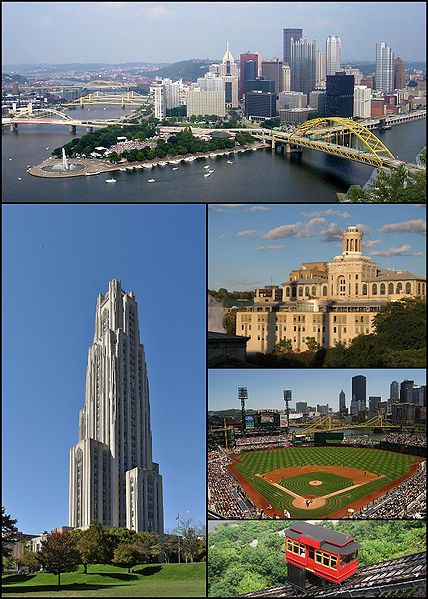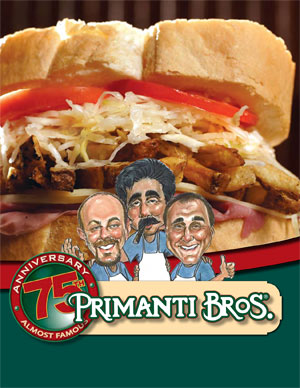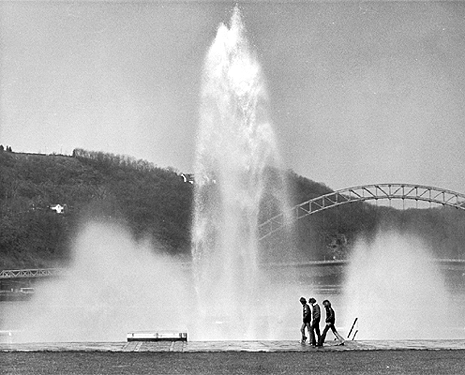
“Yinz goin’ Dahn-tahn, n’at?” Sounds like a foreign language, but it’s not. It’s Pittsburgh. Home of the Steeler Nation, more mullets per capita than any city, and an astounding array of cultural events, outdoors enthusiasts, and ethnic restaurants. Once thought to be a grimy steel town best avoided if possible, Pittsburgh has cleaned up its act, polished its attitude, and gone to college. It’s still a steel town at heart. But now let’s call it a squeaky-clean steel town, shall we?
Lest biases from the past cloud our perception of Pittsburgh today, let’s examine a few Pittsburgh myths to determine their validity. The answers, like the taste of French fries on a sandwich, may pleasantly surprise you.
Myth #1: Pittsburghers are nothing but mullets and I.C. Light beer.
True or False? [Ahem] False. Yes, I hesitated over that one. Maybe I should have gone with true. So whichever answer you chose, go ahead and give yourself credit. Here’s why: At each and every home Steeler’s game, you can wander a parking lot within a five-mile radius of Heinz Field and at every bumper find at least one well-tended mullet and an I.C. Light clutched in a beer cozy. But I hesitate to say we’re nothing but mullets and cheap beer. With those mullets and beer comes a die-hard devotion to Pittsburgh’s sports teams and the grit and determination they represent. Pittsburghers may have a mullet or two somewhere in the branches of the family tree, but every family member has a heart of (black and) gold.
Myth #2: Pittsburgh sandwiches aren’t complete without fries and slaw.

True. You haven’t lived (at least you haven’t lived in Pittsburgh) if you haven’t pawed a Primanti’s ham sandwich sprouting fries like an unshaven chin and dripping cole slaw ooze down to your elbow. The multi-decker sandwich somehow manages to hug slabs of meat, tomatoes, cheese, French fries, cole slaw, and perhaps an egg or two in between two slices of white bread. Primanti’s Restaurant is the kind of place where you don’t dare send a wrong order back to the kitchen. When the cranky waitress with a long knife comes to your table to cut your towering sandwich in half, you smile politely and accept whatever she decides to serve you. (And you keep a wary eye on the knife.)
Myth #3: Pittsburgh has streets comprised entirely of steps.
True. Believe it or not, someone, somewhere decided to make streets out of the flights of steps that traverse the steeply inhabited hills around the city. Around here, we call them Street Steps. It’s not uncommon to come across a bus stop sign located mysteriously in the middle of a highway only to glance to your left to see a crumbling, tottering flight of steps leaping up a hill. No road in sight, but there’s a clear street sign marking that flight of steps. At last count, the City of Pittsburgh claimed ownership of 712 sets of steps that qualify, even on some maps, as actual streets. And the best part? Someone gets to clear those street steps every winter right along with the rest of the highways and byways.
Myth #4: The Pittsburgh area is home to 15 colleges and universities.
False. The actual number is 19. That’s 19 institutions of higher education that are drawing a vibrant, youthful spirit to the city. From the University of Pittsburgh, founded in 1787 and housed originally in a log cabin, to Carnegie Mellon University, home to the Open Learning Initiative, which offers free online courses in thirteen subject areas, Pittsburgh draws everyone from the nerds, to the jocks, to the geeks, to the thespians, to the undeclared majors. Many stay to make Pittsburgh a permanent home. At least all those advanced degrees have taught the kids one thing: grab a good thing when you see it.
Myth #5: Pittsburgh was built by Henry Clay Frick. No, by Andrew W. Mellon. No, by Andrew Carnegie.
True. Or All of the Above. The same movers and shakers who left their fingerprints (and droppings from their wallets) all over New York City also invested heavily in Pittsburgh. Anecdotal facts point to healthy (and at times unhealthy) competition between these three gazillionaires. Pittsburgh still benefits from a bit of healthy competition. There’s Carnegie Mellon University (whose name not so subtly alludes to who won that round). There’s Frick Park, home to the stately Frick Art and Historical Center, the sumptuous garden restaurant Café at the Frick and the popular outdoors concert series, First Fridays at the Frick. Not to be outdone (in life or death), Mellon (Park) treats Pittsburgh audiences to Sunday Brunch outings through the Bach, Beethoven, and Brunch Classical Music Series. Around the ‘Burgh, we’re happy to see the big wigs try to one up each other.
Myth #6: Pittsburgh is famous for three rivers.

True. And False. (Give yourself credit either way.) We’ve earned a name for ourselves with three rivers colliding at the triangular snout of Downtown. Our rivers are industrial, with barges chuffing along the Ohio and Monongahela (bonus point if you know its nickname: The Mon). The rivers are also recreational with families swimming, boating, tubing, and grilling hot dogs along strings of islands dotting the Allegheny River. There’s a fourth river, though. A secret river. Most Pittsburghers call it the Underground River, since its real name, Wisconsin Glacial Flow, doesn’t quite make sense in our neck of the woods. The Underground River does make one notable appearance topside at the Point Park Fountain, which spews forth water from the Underground River, pumped to the surface to mark the tip of Downtown and welcome visitors from all directions.
Pittsburgh. An unexpected gem of a city. Given a chance, Pittsburgh will bust most, if not all of the tarnished city myths erected in the past. For one final trivia question, can you translate Pittsburghese? “Yinz goin’ Dahn-tahn, n’at?” That’s Pittsburgh for: “Are you going Downtown, and all that?” Sure. Give yourself one last bonus point for that one.

Cute post! One correction – It’s I.C. Light. I don’t drink the stuff myself, but I know the “I.C.” stands for Iron City.
Mollie, thanks for the correction. I can only laugh at myself and say that the “Icy” Light typo shows that I am indeed a transplant and not a native to this city. Thanks for catching it!
This was great and I can’t wait to share it with a Williamsport family moving to Pittsburgh!